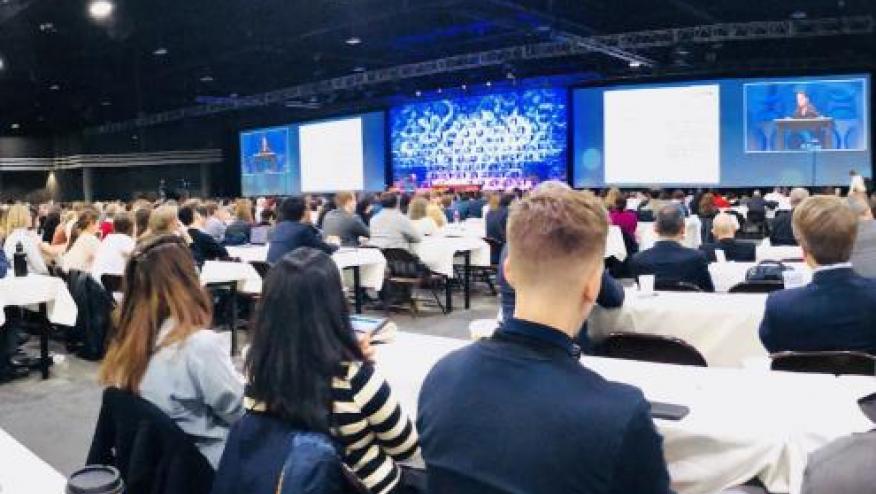EULAR 2022 – Day 2 Report Save

A full day at EULAR with oral and poster presentations of abstracts in the morning and a plethora of scientific (review) sessions in the afternoon. The latter covering topics like sarcoidosis, Still’s disease, fibromyalgia, back pain, sarcopenia, APS, IgG4 and imaging in vasculitis. (Watch the Day 2 Faculty Recap Panel)
Here are several of my favorites from Day 2.
- PROOF Study: Radiographic Progression from Non-radiographic to Radiographic Axial Spondyloarthritis. Abstract OP0149 – Dr. Denis Poddubnyy presented a prospective cohort study of 562 patients. He noted that the literature suggests approximately 20% of newly diagnosed axSpA patients have nr-axSpA and that 8-40% of these will progress radiographically in the subsequent 2-10 years. In his study of 562 nr-axSpA patients, they followed patients for 5 years and showed that approximately 16% progressed to axSpA, with a mean time to radiographic axSpA of 2.4 years. Predictors of progression were male gender, fulfilling the imaging arm of ASAS criteria, HLA-B27 positivity and a good response to NSAIDs (probably reflecting active inflammatory disease).
- Infections Drive SLE Flares. Abstract OP0143 – A cohort study of 184 mild to moderate SLE patients followed for a median of 6 years looked at the relationship between minor (non-serious, URI, etc) and major (hospitalized serious infections) and lupus flares. In this population 19% had biopsy proven nephritis, half were on steroids, 74% on hydroxychloroquine and 37% were on immunosuppressives. They showed the risk of major infections was 5.3 per 100 patient-years (PYs) and minor infections was 63.9 per 100 PYs. They noted 38 major SLE flares (incidence rate 3.6 per 100 PYs) and 160 minor flares (15.1 per 100 PYs). There was a clear increase in the risk of all SLE flares (within 3 mos. of infection) with a hazard ratio of 1.9 (95% CI 1.3-2.9) and of major flares (HR 7.4). Thus, major infections in SLE increased the risk of major SLE flare over 7-fold.
- Future cancer risk with biologic use in prior cancer patients? Abstract OP0138 – Data from the BIOBADASER (Spanish) biologics registry identified a total of 354 patients with a prior history of cancer who later went on to receive a biologic or JAK inhibitor and were enrolled in this prospective registry. From a total of 9129 patients in BIOBADASER, 352 had a prior malignancy (94% non-lymphoproliferative solid CA or melanoma, 8% lymphoproliferative, 6% lymphoma, 2% leukemia). Future cancer was seen in 32 (9%) – this included 17 solid cancers, 14 nonmelanomatous skin cancers and 1 melanoma. Incident cancer occurred a mean of 4.5 years after starting the biologic. Biologics used in these patients included TNFi (n=184), JAK inhibitor (81), RTX (61), IL-6 inhibitors (68), abatacept (47) and IL-17 inhibitors 39). Overall, the risk of incident cancer in those with a prior malignancy did not differ according to the bDMARD or tsDMARDs received and the mortality rate also did not differ according to drug.
- Topical Bicarbonate for Gouty Attacks? Abstract OP0179 – Dr. Puja Khanna presented the results of a novel intervention trial in patients with acute gout. This was a phase 2a prospective, double-blind, randomized, placebo-controlled study of 98 acute gout patients who were all treated with standard dose colchicine and then randomized to receive either a placebo lotion or transdermal NaHCO₃ over the involved joint. Surprisingly the transdermal bicarbonate group had a 94.5% response compared to 79.3% (p=0.01) on placebo arm. Moreover, the intervention group had lower rescue med use (6.3% vs. 20.0%, p=0.02); faster resolution and greater improvements over 7 days (22.2 vs. 16.7 points, p=0.05). How or why, this worked is uncertain, but was postulated to lower pH in the joint, resulting in less crystal formation – this requires further study.
ADD THE FIRST COMMENT
Disclosures
The author has no conflicts of interest to disclose related to this subject










If you are a health practitioner, you may Login/Register to comment.
Due to the nature of these comment forums, only health practitioners are allowed to comment at this time.